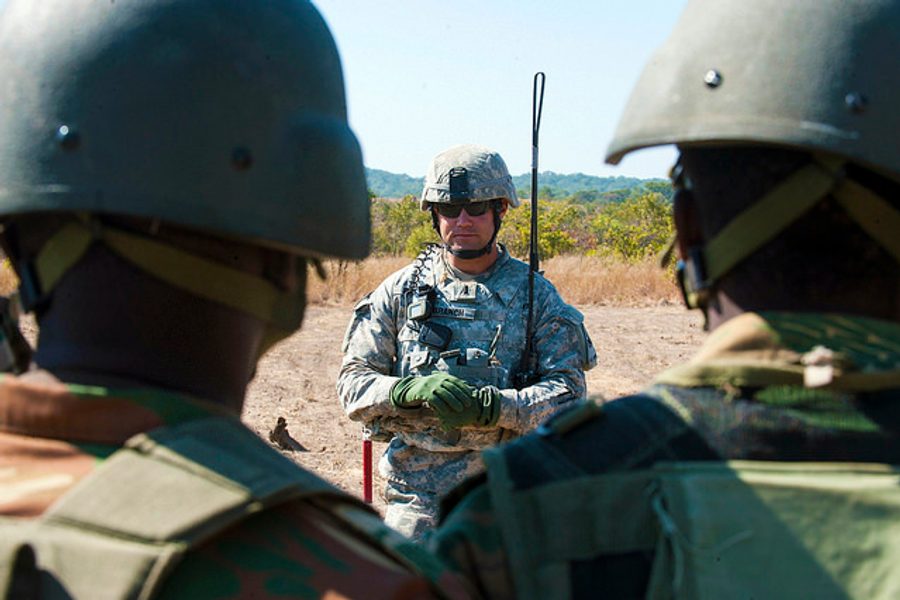Don’t Ask, Don’t Tell: The U.S. Military Is in Africa—But What Is It Doing There?
Journalist Nick Turse discusses his new book, Tomorrow’s Battlefield: U.S. Proxy Wars and Secret Ops in Africa.
Marc Daalder

The United States military is a global force, with bases spanning six continents and dozens of countries. Its expansion in East Asia makes headlines and triggers protests around the world; forces fighting in countries as distant as Ukraine and Syria receive military aid; over the past several decades, it has crippled South American insurgent groups and still performs large scale training operations in Central America.
The one continent in which U.S. military action rarely receives any attention for is Africa. The U.S. maintains just one backwater base in Djibouti, Camp Lemonnier, and rarely advertises its military actions there.
Nick Turse, an award-winning journalist, looked deeper into the state of U.S. military affairs in Africa in a series of articles for TomDispatch.com, where he is an editor. These articles have been collected in a book entitled Tomorrow’s Battlefield: U.S. Proxy Wars and Secret Ops in Africa. Turse spoke with In These Times recently to discuss what the U.S. military is up to in Africa.
How did you get the idea to write the book?
It had very humble beginnings. I asked the public relations people at U.S. Africa Command, or AFRICOM, to answer a few simple questions about the scale and scope of their involvement on the continent. I asked these questions because I started seeing indications of increased U.S. operations for a couple years. But I got a public relations brush-off — prattle that didn’t match up to what it seemed to me they were actually doing in Africa.
I had seen the outlines of a very sophisticated logistics network being set up. Now you don’t build a logistics network — ferrying supplies all across the continent — unless you’re planning on sending personnel all across the continent, unless you’re planning to man outposts and bases. But when I asked about this, they talked about how light their footprint was. Because these things didn’t match up, I started digging more and more.
If they had told me anything that resembled the truth — what I was finding out through my reporting — I probably would have written one article and moved on. But because it looked like they had something to hide, I decided to dig.
The standard image of U.S. military involvement in Africa is one of almost entirely humanitarian work. You reveal in the book the astounding ineptitude in our humanitarian and aid work there, as well as the ulterior motives for helping out in the first place.
If you reach out to AFRICOM public affairs, they like to talk about humanitarian missions. To hear them talk about operations in Africa, you’d think that AFRICOM was some sort of cross between the Peace Corps and Doctors Without Borders.
They do a lot of humanitarian operations on the continent, or things that look humanitarian. This is the only thing they like to talk about. But if you listen when officers talk to each other, or talk to military contractors, or read internal memos, you hear a very different story. They don’t talk about the humanitarian operations — they talk about Africa as a battlefield or a continent where they’re “at war.” This is diametrically opposed to the humanitarian veneer that they try and project to the public.
One of the biggest questions that you work on answering in the book is why the U.S. wants to keep all of this secret. What are some of the top reasons the U.S. is hiding its military presence and military goals in Africa from the public?
One of the major reasons that gets mentioned (offhand, sometimes) by their commanders is that they’re afraid of the response in Africa. Commanders have sometimes obliquely mentioned the fact that Africa’s colonial past means they need to tread lightly. They aren’t operating with a very light footprint at this point, but they still want the perception to be out there.
This is also just the default position of the U.S. military for almost anything. I put in hundreds of FOIA [Freedom of Information Act] requests a year for basic information only to see them rejected. This is just part and parcel of how the military operates. They’d rather not answer any questions.
You say that since 9/11, the number of failed African states has almost doubled and many more terrorist groups are operating on the continent. Is U.S.-involvement to blame for this unrest?
It’s always difficult to pin down causation on any of these things. There are certainly underlying or internal issues in these countries that don’t have anything to do with the U.S. That said, the United States certainly contributed to destabilization in a lot of ways that have paved the road for increases in problems all across the continent.
One of these instances that I talk about in the book is of course the 2011 war in Libya, which I think the U.S. saw as a “no-brainer” — that you could fight it on the cheap, at least as far as U.S. lives go, fight it from the air. You have Libyan forces on the ground and then European partners that you can lean on. It was seen as a major win. But the U.S. government always has a problem of not understanding the repercussions of its actions down the road.
The problems with the revolution in Libya was that [mercenary] Tuaregs who were fighting for Gaddafi looted his arms stores, returned to their native Mali and destabilized the government there. That led to a coup by a U.S.-trained officer in Mali. He seemed to be incapable of fighting against the Tuareg insurgency, and that emboldened an Islamist insurgency that muscled the Tuaregs aside. That meant the U.S. had to back an African and French force to beat back the Islamists. Now, Mali is in a very fragile state.
This was once seen as a real bulwark for the United States, an anti-terror bulwark in West Africa. And beating back the Islamists as the French and Chadians and other forces did, just spread them out through other countries in the region and caused mass destabilization there.
Unintended consequences seems to be the U.S. stock and trade. So while they may not be completely responsible for any of these things, they certainly have played an important role in them. Besides the Libya example, you can see it all across the continent. In Somalia, Al-Shabaab was beaten back, but now is a regional threat instead of one that was confined to Somalia.
In the same way that Mali was a bulwark for the U.S. military and in general a success story, there’s a lot of other countries that for a while were success stories but now are starting to fall apart — South Sudan, for example. In the final chapter, you talk about how Chad is in some sense seen by the U.S. as the new anti-terror bulwark for Africa, but has many issues with an authoritarian regime and U.S.-trained forces who are actually prone to atrocities in other countries and at home.
The Chadians are seen as a real success. They’re seen to be very potent fighters on the battlefield and a proxy force that can be used in lieu of putting U.S. forces or even large numbers of European forces on the ground. But the issues you raised are ever-present.
In the State Department’s Human Rights reports that they put out every year, if you look at Chad, the country is cited every year for various forms of human rights abuses carried out by security forces: extrajudicial killings, torture, assault. Also United Nations reports, Amnesty International, Human Rights Watch, they’ve all cited Chad for military crimes outside of its borders. This is the force that the United States is hanging its hat on.
And even in Mali, when the Chadians were on the ground there — they’re supposed to be very powerful desert fighters, but they were taking casualties in the first few months and decided that their army, that we had trained, wasn’t suited to guerilla warfare, and withdrew their troops. These are the allies that we’re creating. It’s very problematic even from the U.S. military’s point of view. I would have to think if this is your top ally, that you’re really in very rough shape.
Are any of the United States’ proxy forces using child soldiers? Is that an issue that AFRICOM thinks about?
Chad’s forces just a few years ago were involved in a report from Amnesty International about a massive recruitment of child soldiers. So this is one of the U.S.’s main proxy forces and it institutes them. One that I’ve written about a couple times is South Sudan, where it’s well-known that South Sudan’s armed forces had child soldiers at the time of independence. They made a pledge to rid the army of child soldiers. And on this proviso, the United States, which is barred from giving military aid to forces overseas that employ child soldiers, issued a waiver for that first year, 2011.
South Sudan said by the end of the year that they would let all the child soldiers out of the ranks — but they never did. And the U.S. continued to issue waiver after waiver, allowing South Sudan’s armed forces to grow, to receive U.S. equipment and supplies, while they still had children in the ranks. When South Sudan exploded in civil war, all those years of waivers meant there were child soldiers who were already there and the government’s military and the offshoot rebel forces both began extensive recruitment of child soldiers.
This was engrained in both those militaries as they came out of the one which the US had funded. In many ways, the United States set the stage for it. Once the civil war began, both sides were looking for any advantage and they didn’t hesitate from recruiting children. Perhaps if they had already been eliminated from the armed forces, if there had been a culture change, that wouldn’t have been the first place these armies would have looked to increase their ranks.
One country that’s had a better track record in Africa than the U.S. is China. You have a whole chapter where you talk about the different approaches between China’s and the U.S.’s takes towards involvement in Africa, militarily but also economically.
If you look at the Chinese role in Africa since 9/11 and the U.S. role since 9/11, you’ll see that two diametrically opposed paths were taken. The Chinese decided that they would go an economic route — that that’s how they would build inroads. And the U.S. has decided on a “whack-a-mole” counterterror strategy where they would throw money at various terror problems that they saw on the continent and help build up allies that way.
China now has very deep ties with African nations all over the continent. It has created public works projects, big projects that Africans can see and touch with their hands, while the US is trying to build up militaries there. The Chinese have been much more successful at what they’ve done. There are a lot of problems with how China works on the continent in terms of the environment, labor rights — it’s not a rosy picture by any means. But I think it has been very effective, whereas the U.S. strategy hasn’t been.
What are the best steps to take in ensuring Africa’s stability? Or is that not really a U.S. responsibility?
If you look at the results of the last five years, terrorism on the continent has spiked by all objective measures at the same time the U.S. has been pouring more and more money into counterterror. Terror groups have spread as we’ve been trying to constrain them. I think that it might be time for the U.S. to rethink things.
If that means a completely hands-off policy, perhaps that’s it. Perhaps it’s an engagement strategy that’s more in line with what China has done to try and build economic ties and raise up African economies instead of trying to raise African militaries. But somehow, there has to be a rethink. When the exact opposite of your plans come to fruition after spending hundreds of millions, billions of dollars, obviously something’s gone wrong.







